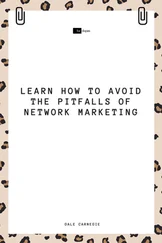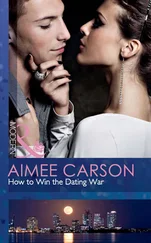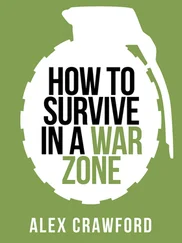Rubber bulletscome in many shapes and sizes. Some of the smaller ones can cause major injury and even death if fired at close quarters (less than 40 metres). Well-trained riot police should aim for your legs, but if they miss and hit your eye, the bullet will blind you. If you have ever played paintball you will know how much it can hurt to be hit with a non-lethal weapon, and these ain’t no paintballs – many of them are actually rubber-coated steel bullets. You should be able to tell if the troops are firing rubber bullets because there will be a small, bucket-like container attached to their weapons instead of a normal magazine of bullets. There may also be a large structure attached to the end of their gun. But don’t wait around to see if they are firing real bullets or not. There is no way to predict what type of ammunition is being fired at you. Get away from them as quickly and calmly as you can.
Chemical weapons, such as tear gas, are often used to disperse riots. In fact, exposure to tear gas is also part of British army training – to help you learn how to put on your nuclear/biological/chemical weapons kit under stress within 10 seconds – and also to familiarize you with the effects of tear gas and learn how to cope with them. So there you are, standing in a dark hut listening to the short, nervous breaths of the soldier beside you, and suddenly the gas comes on. A sergeant wearing his gas mask shouts at each of us to sing the nursery rhyme ‘Mary Had a Little Lamb’ before we can put ours on. By then it’s too late. The gas is in your now-weeping eyes, your sour-tasting mouth, making your skin itch and breathing difficult. But soon it’s over. We are outside breathing fresh air. A minute later we are shoved back inside for another round of spluttered singing, until no one in that tiny little room shows any sign of panic. We are all resigned to our painful fate. The training worked. What I learnt first of all is that contact lenses are evil after exposure to tear gas. Even worse, you have to put a contaminated finger in your eye to take out the piece of plastic that now feels like a shard of glass. Your nose will run, your mouth will water. You will cough and you might feel dizzy.
TEAR GAS AND PEPPER SPRAY TIPS
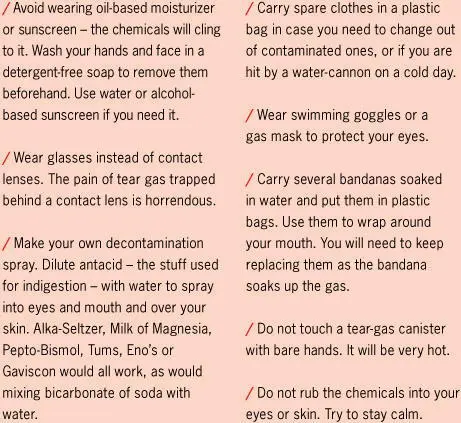
For the rest of my year in the army I was still able to feel a burn in my eyes every time I put on my gas mask for training. Tear gas and pepper spray will stick to everything exposed, and also to anything you touch, before you manage to wash it all off. You might find yourself feeling the effects for days afterwards if you don’t decontaminate before entering your home. These weapons are toxic, but the immediate effects of tear gas will wear off after half an hour in fresh air.
I am told that the pain from pepper spray is more instant and intense, and that you might also feel a strong sense of anger. Pepper spray is much harder to remove from the skin. In a high concentration, it can also cause first-degree burns if left on the skin. In a normal concentration, most of the painful effects should disappear within two hours of moving away from direct exposure.
It is worth remembering that crowds are not always going to be hostile. Some come in peace. If you are in a position of authority, they might be more afraid of you than you are of the thousands of them.
Samantha Bolton remembers: ‘Refugee crowds without leaders can be organized, especially when in shock. We were the first to see over a million refugees come over the border in Goma after the massacre in Rwanda in 1994. They streamed over in silence in just two hours. They were like dumbstruck cattle and went just where I told them as I was the only figure of authority around. The key is not to be afraid, and to pick out a possible leader if you need someone to negotiate with.’
/BODY ARMOUR OR FLAK JACKETS
You put on your underwear, you put on your trousers and a shirt, then on goes the body armour. The longer you wear it, the heavier it gets. If you are running around, it gets sweaty and dirty. If it doesn’t fit very well, it will start to rub and bruise, and then – ouch! – it really hurts.
I wore a flak jacket for 21 days in a row while on exercise with the army. We were told we had to sleep in it, so we did. My arms and hips were bruised for another three weeks afterwards. By the time I emerged from my armoured cocoon, what little need I had for a bra had disappeared and instead I found a washboard stomach.
There is a big debate over whether civilians should wear body armour at all. People working for NGOs often don’t as they say the logo on their cars and shirts are protection enough.
Some people, like my colleague Zeina Khodr, are fatalistic: ‘I don’t believe in armour. If it is your day to die, it is your day. And also it’s important not to look different from the people around you.’ Others reinforce at least part of this view. Qais Azimy says: ‘I don’t wear expensive clothes any more – it just draws attention. I try to look more like a local. Body armour too just puts you more in danger.’
THE CORRECT WAY TO WEAR A FLAK JACKET
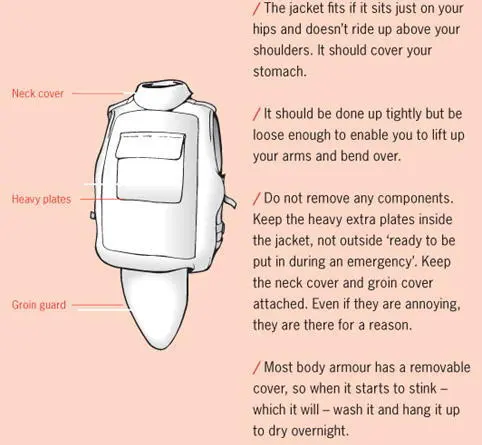
Many even question whether it will save them if they are shot. It is a pain to wear, but feels pretty flimsy when you know it is supposed to defend you from bullets and shrapnel. Captain Sayed Hashim told me: ‘The Afghan National Army did not used to have helmets and body armour, but now we are getting more – almost all of us have armour. We wear it, but I know it doesn’t make any difference to whether we survive or not. That is Allah’s will.’
Some people, such as Nick Toksvig, feel the advantages of wearing flak jackets far outweigh the negative aspects: ‘The jacket isn’t difficult to wear. I have seen it save someone’s life when they were shot directly in the chest. At the very least it will hold you together if you are hit. A cameraman I know was working with his flak under a shirt. He was looking straight down the camera and someone came up and stabbed him from behind. The attacker hit the jacket, his hand slid down the knife and he actually ended up cutting himself. My friend ran for his life.’
Shelley Thakral is pragmatic about wearing body armour: ‘It’s just a necessary part of my kit. Not just for me, but for everyone around me. Of course, you have to know when to wear it, when you don’t stand out. But wherever you are, it is another layer of security. As a journalist, I am exposed, so I need to take extra precautions. The risks of not wearing it are not worth taking.’
Leith Mushtaq says: ‘It seems pointless to wear the body armour, but wear it anyway so that no one can accuse you of not taking care of yourself if you are hurt. However, don’t wear the body armour if you are going to be a target as a result of it.’
If you are lucky, your body armour will be like a jacket, something to put on when you are leaving the house. But you might find yourself wearing it for hours and days and weeks on end.
Sherine Tadros told me: ‘I’ve had big problems with flak jackets. I’ve tried different sizes with different plates, but they all have one thing in common – they are damned heavy. I found wearing one for a day or two, as I did in Lebanon, just about bearable, but in Gaza, for 23 days, it felt like I was carrying the kitchen sink on my back.’
Sherine offers the following ideas to reduce post-flak back pain:
Читать дальше
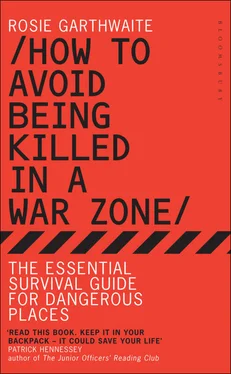


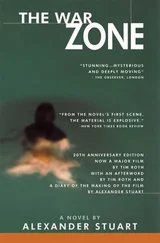


![Джонатан Димблби - Barbarossa - How Hitler Lost the War [calibre]](/books/385421/dzhonatan-dimblbi-barbarossa-how-hitler-lost-the-w-thumb.webp)



